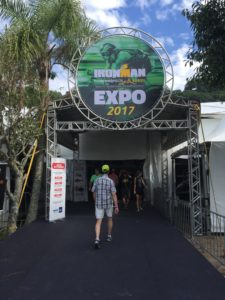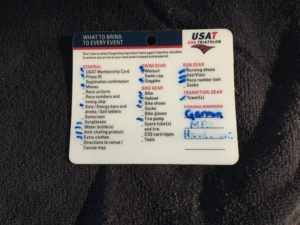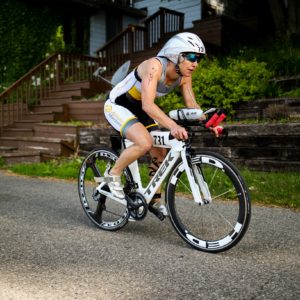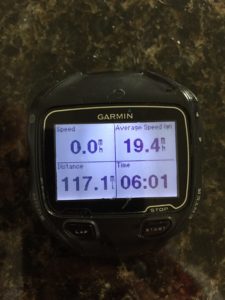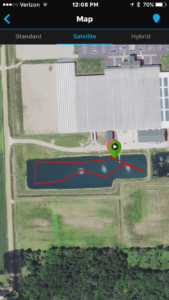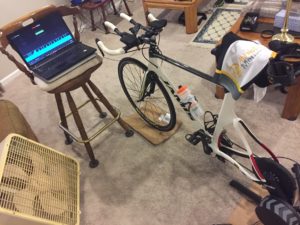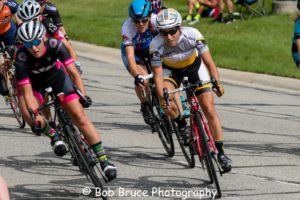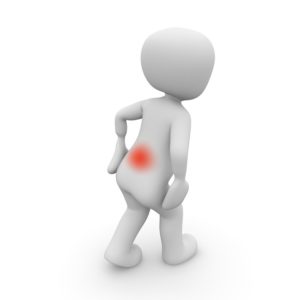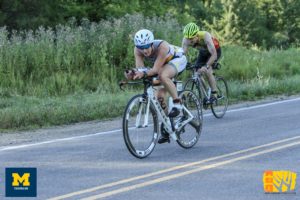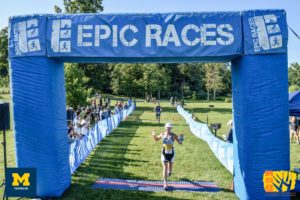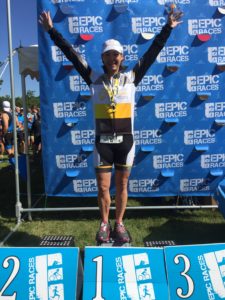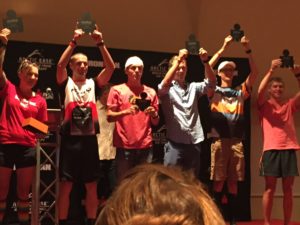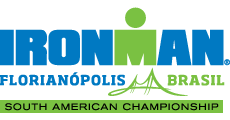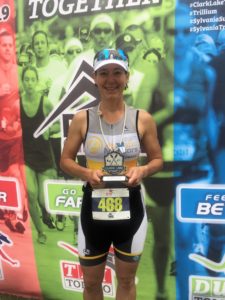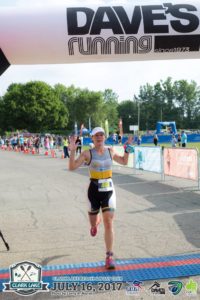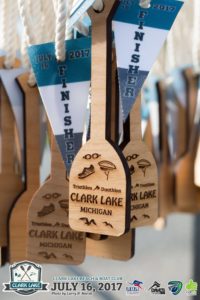–By Brian Reynolds
This blog is a continuation from my last blog post “My Kona Journey: Part 3”. I would suggest reading that blog before reading this one.
“Only he who can see the invisible can do the impossible.” – Frank L. Gaines
It was early May and less than one month to go until Ironman Brasil! During the month of May I did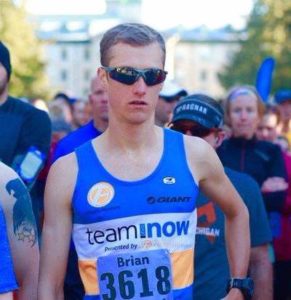 two races which were the Borgess run and the Muncie May Triathlon. I’ve ran the Borgess run 4 years in row and wanted to continue on with that tradition. On May 6th I did the Borgess 10k run which was a “C” race for me. I went into this race in a non-rested state since my Ironman training took priority. I was able to get the overall win in a time of 33:32 which was the fastest time I’ve ran on that course. I was really surprised of how well I ran considering my legs felt fatigued from training. This race result showed that I had good run fitness which was a big confidence booster heading into Ironman Brasil.
two races which were the Borgess run and the Muncie May Triathlon. I’ve ran the Borgess run 4 years in row and wanted to continue on with that tradition. On May 6th I did the Borgess 10k run which was a “C” race for me. I went into this race in a non-rested state since my Ironman training took priority. I was able to get the overall win in a time of 33:32 which was the fastest time I’ve ran on that course. I was really surprised of how well I ran considering my legs felt fatigued from training. This race result showed that I had good run fitness which was a big confidence booster heading into Ironman Brasil.
The following weekend on May 13th I did the Muncie May Triathlon which was an Olympic distance race in Muncie, Indiana. The race was one of the first triathlon races in the Midwest. I was trying to find a race further South to get some warmer temps but there weren’t any others on that weekend. The race was on a Saturday so I drove down to Muncie on Friday and checked out the course. The water temp was 58 deg F which will be the coldest water I would ever swim in! The bike course was a 2 loop that was mostly flat with a few rolling hills. The run course was a out and back which had rolling terrain.
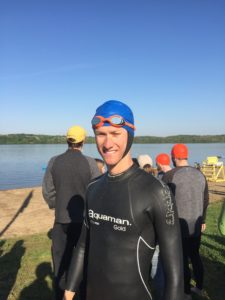 On race day there were a few delays which pushed my swim wave start to 9:50am. Before the start I swam in the lake to get my body acclimated to the freezing water temps. When I stuck my head in the water it took my breath away but after a few minutes my body adjusted. I wore a skull cap to help keep my head warm. When the race started I got off to a good start. I was swimming with the leaders for the first 300-400 yards. Eventually the leaders started to pull away which was unusual because I usually keep a even pace throughout the swim. I think the cold water temps were getting to me because my body was using its energy to stay warm. I ended up fading to 6th place coming out of the water. I tried to stay positive and thought that once I got to the bike I would be ok and would make up those lost positions.
On race day there were a few delays which pushed my swim wave start to 9:50am. Before the start I swam in the lake to get my body acclimated to the freezing water temps. When I stuck my head in the water it took my breath away but after a few minutes my body adjusted. I wore a skull cap to help keep my head warm. When the race started I got off to a good start. I was swimming with the leaders for the first 300-400 yards. Eventually the leaders started to pull away which was unusual because I usually keep a even pace throughout the swim. I think the cold water temps were getting to me because my body was using its energy to stay warm. I ended up fading to 6th place coming out of the water. I tried to stay positive and thought that once I got to the bike I would be ok and would make up those lost positions.
When I got to the bike I notice within the first few minutes of the ride that my power numbers were low. I was riding 30-40 watts lower than what I expected. On lap one I got passed by two riders and I started to get disappointed with myself. I thought to myself “Man I did all this hard work on the bike and this was all I could show for it.” I didn’t give up and just kept pushing. When I started the 2nd loop I started to pick up the pace. Within a 5 minute window my power started to gradually climb from 240 to 250 to 260 to 270 to 280 to 290 watts. I got a 2nd wind and the engines were running on full power. The two guys who passed me early on in the bike I could not see but I knew if I kept pushing I could catch them. I was able to catch both with 2 miles left to go in the bike. It turned out that I was in the lead coming off the bike so I felt confident that I had the race at hand since my run was my strongest discipline. I managed to grow my lead and win the race. This race showed me that ANYTHING can happen and you can go from a low point to a high point as long as you keep pushing.
After Muncie I had 2 weeks until Ironman Brasil. The final 2 weeks were lighter workouts since I was beginning my taper. My dad and I left for Brazil on a Tuesday (5 days before the race) and arrived in Florianopolis, Brazil on a Wednesday. The total flight time was 15 hours through 3 different connections. After landing in Florianopolis we had to drive 45 minutes to the hotel which was a few miles away from the race venue. On our drive I was able to checkout the landscape and the bike course. Florianopolis was a very hilly and pretty area. Fortunately the bike course is mostly on the highways which is mostly flat with a few big hills along the course. The scenery was beautiful especially near the coastline. It definitely felt like I was in a different country because the buildings, roads, and cars were different compared to the US.
On Thursday I did a 45 minute easy run which did not feel smooth or easy. During this run it felt like I left my running legs in Michigan. I didn’t worry too much over this run because it could’ve been due to the long flight or the taper effect. I knew that I was fit and that I would be ready to race. Later than day I did the athlete check-in and checked out all the cool triathlon toys at the expo!
On Friday I did a open water swim near the Ironman start. I probably couldn’t have picked a worse day to go for a swim. There were 5 to 8 foot tides crashing into shore. This made me worry because I thought this was normal and this would be the race conditions on race day. I manage to have the courage to go for a swim but it was rough. I was getting saltwater in my mouth. I had a hard time sighting since I couldn’t see over the tides. The waves were tossing me around for 30 minutes. There was an instance when I was swimming back to shore a big wave flipped me over on my back! After the swim I talked to a few folks about the ocean tides and they said that those conditions were not typical. Usually the water is a lot more calm and race officials would’ve cancelled the swim in the conditions I swam in which made me feel more at ease.
The day before the race I did my final workout which was a bike and run. I did a 25 min bike and a 15 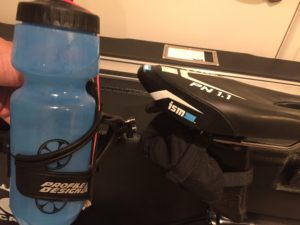 min run. On the bike I tested out my race equipment by placing two filled water bottles in my rear bottle cages to make sure they did not fall out while riding on the cobblestone roads. Yes, there is a section of cobblestones for .5 miles near the start of the bike. The good news is that my bottles did not fall out; however, the bad news was that my rear bottle cage broke! Literally on the 2nd to last speed bump heading back to the hotel I heard a “thud” sound. I was really surprised but it’s good that it happened now and not during the race. If this happened during the race it would’ve had a big impact on my race since two bottles were two hours worth of nutrition. Fortunately I was able to buy another rear bottle cage at the Ironman expo.
min run. On the bike I tested out my race equipment by placing two filled water bottles in my rear bottle cages to make sure they did not fall out while riding on the cobblestone roads. Yes, there is a section of cobblestones for .5 miles near the start of the bike. The good news is that my bottles did not fall out; however, the bad news was that my rear bottle cage broke! Literally on the 2nd to last speed bump heading back to the hotel I heard a “thud” sound. I was really surprised but it’s good that it happened now and not during the race. If this happened during the race it would’ve had a big impact on my race since two bottles were two hours worth of nutrition. Fortunately I was able to buy another rear bottle cage at the Ironman expo.
That late afternoon I started packing my equipment and nutrition. For the bike I prepared five bottles of my Infinit bike blend that I would carry on the bike. I had one bottle in my aero bars, two bottles on my frame, and two bottles in my rear bottle cages. To take extra precautions I packed two extra bottles in my bike special needs bag just incase I lose any bottles during the race. For the run I prepared six 10 oz flasks of my Infinite run blend. Each flask had 30 mins worth of energy and I plan on running for 3 hours which meant I needed 6 flasks. I would carry three flasks out of T2 and then pick up the other three flasks in special needs.
The last agenda items to do before the race day was eat and get to bed early. We had a buffet dinner so I could pick and choose what I wanted. I limited my fiber intake and ate foods that I was more familiar with. Not worth experimenting with different foods in a foreign country the day before a race. After dinner we went to bed shortly after. It’s usually hard for me to get a good night’s sleep before the biggest race of the season.
All the hard work was done and now it was time to reap the benefits tomorrow. I was in the best shape of my life and felt confident that I could qualify for Kona as long as I executed my race plan. The forecast for tomorrow was rainy with the temps in the high 60s. At least I didn’t have to worry about it being too hot:)
To be continued….






